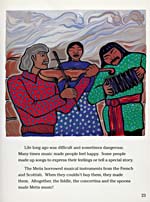Common menu bar links
Institutional links
ARCHIVED - Our Voices, Our Stories:
First Nations, Métis and Inuit Stories
Archived Content
This archived Web page remains online for reference, research or recordkeeping purposes. This page will not be altered or updated. Web pages that are archived on the Internet are not subject to the Government of Canada Web Standards. As per the Communications Policy of the Government of Canada, you can request alternate formats of this page on the Contact Us page.
Voices of Métis
Métis—Stories of Here and Now
The very essence of Métis stories in the Aboriginal world reflects evolution and change in line with contemporary realities. Métis prayers and poems are continuously being added to the body of Métis stories. Even the central stories can differ according to the storyteller or a particular setting. At times, stories can be perceived as "growing trees" whose leaves change colour depending on the season.
To this day, some Métis stories are very sacred and can only be recounted to, and by, specially designated individuals. Other stories have been translated into various pieces of visual artwork and into music. For instance, there are various Métis stories and art forms that recount the events of the Red River Resistance (Manitoba, 1869-1870) and the Northwest Resistance (Saskatchewan, 1885).
Modern technology has significantly influenced the manner in which stories are told, making them available on the Internet, in audio format, on radio, television and film, or in written text. Some people contend that this distorts the art of storytelling and may interfere with the presentation and substance of the story. However, now with increased literacy in Métis communities, the Métis are able to record and transmit their stories to a broader audience. It is important for the audience to remember that these stories form a part of the cultural knowledge of various peoples, and that they are intended to create public awareness and understanding of Métis culture. They must be respected and used wisely.
There is a new wave of Métis storytelling that draws on oral tradition to create artistic expressions. Some storytellers rely on stories of long ago, utilizing different media to transmit the story, whereas others use old methods, such as beadwork, or contemporary methods, to invent or record new family and community stories. In addition, Métis writers such as Marilyn Dumont, Gregory Scofield, Rita Bouvier, Joanne Arnott and Joseph Boyden have written depictions of a given person's history and family, utilizing a selection of biographical and cultural elements. (View book covers of works by Marilyn Dumont, Gregory Scofield, Rita Bouvier.) Métis storytelling is an art and its only true boundaries are those of inherent respect for the heritage and culture of the Métis.
Despite all these recent innovations and discoveries, continuities and artistic diversifications, Métis stories are still just as important as they have always been, if not more. They embody the traditions and history of one of Canada's Aboriginal peoples, a proud people, who have come to call themselves Ohtipaymsowak or the "People who own themselves."

Source
The Flower Beadwork People, by Sherry Farrell Racette, Regina: Gabriel Dumont Institute, 1991

Source
The Flower Beadwork People, by Sherry Farrell Racette, Regina: Gabriel Dumont Institute, 1991

Source
"I've Been Told," from I Knew Two Metis Women, by Gregory Scofield, Victoria, B.C.: Polestar Book Publishers, 1999
